#lobster facts
Explore tagged Tumblr posts
Text

wooden pews in a small chapel with a shining floor, red and blue light. the image is distorted by VCR static. white text reads:
[031] THE WRONG TURN. A CALLER LOSES DIRECTION. THE HOST REACHES BACK.
listen here, or anywhere you find your podcasts. transcript under the cut:
[static, radio tuning]
[Traveling Sales Rep: Don’t touch that dial! We’ll be right back, after these short messages.] [static, radio tuning]
[click]
Hello and welcome to Thin Places Radio. I’m your host,
and it is the middle of the night. But don’t worry. You’re not alone.
[Thin Places theme]
[wind blowing] [wood creaking] [clock ticking]
I’m coming to you… from my studio, which is what I like to call this rickety chapel, closed up for the week, waiting for Sunday. I can hear the wind whistling in the cracks of the old wood, feel the whole frame shudder. There’s stained glass in the windows, but I can’t tell what color any of it is. Does God stay behind in the places we’ve carved out for him, when no one’s left? Does anything else?
So… what is Thin Places Radio? Well, you can call in about anything strange that you’ve got going on in your life - feelings, omens, premonitions, hauntings.
Are you retracing your steps, even when you can’t remember where you’ve been?
Are you lost in your own hometown?
Are you reaching out for something you can’t experience?
Call in, get it off your chest. Lines are open.
[click] [voicemail:]
Never done anything like this before, but I figured that you might understand? I have a amazing sense of direction, I’ve - I drive somewhere once and I know how to get there, I never get lost. The other day last summer, I was headed to the post office by my house, and I'm driving down the road and I - I'm not recognizing any of the landmarks. And I’m like, well, that’s weird, I must’ve just passed it. So I turn around and I drive back, I’m driving further, and I'm passing the intersection, I’m like, well I must’ve passed it again.
I drove up and down that road three times before I finally had to pull into a parking lot. And I pulled up my phone and my map and - I was on the opposite side of town? I wasn't anywhere near my house or near the post office and I have no clue how I got there. I was so freaked out that I went straight home and I put it in my GPS even though I knew how to get there, I just - just to double check. I thought that was kind of weird. And you know, if you're still looking for a name, Host, you know, hopefully you find yours, but maybe Jade would work in the intro? Just a thought. Bye.
[click]
I do. I understand. Out of all of the things I have experienced, this is the most frightening: a lapse inside of my own world, or inside of my own mind. [eerie, curious music] Sometimes when you’ve lived somewhere for years, you wake up one day and its familiarity makes you feel sick to your stomach. You think, why? Why am I here? What is my purpose? The same misery, every day, on its own reliable schedule? You get in your car after work and you begin to drive home. But you miss your exit. And you think, I could - I could keep driving. I could keep driving all night, until I don’t recognize anything. Until I don't -
[music stops]
I’m sorry, that's... not what you were talking about. I don’t know why I said that. Let me try again, caller.
You were pulled into something wrong, on your way to that post office - something uncanny, unfamiliar when it should have been understandable. Transported, or perhaps transformed. It’s terrifying to look up and not understand how you got there. [searching music] To not recognize the shape of your own life.
I think that there are two things you can do when you get to that parking lot: one, you can take advantage of that strangeness your life has become and say, I’m somewhere new now. I didn’t expect to be here, but I’m going to explore it. Or two, you can do what you've already done: look around at this unfamiliar new place and say, no, no, no, I can’t be here. I have to find my way back home.
Thank you for the name, caller. Jade. Carveable into a thousand different shapes but not easily broken. Resilient. It’s a good name. I wish it was mine.
And, just in case - as always - say it with me - please check your home for carbon monoxide.
[click] [clock ticking]
Something strange, listeners. There is a type of deep-sea squat lobster that eats wood. It is called Munidopsis andamanica. It waits there, in the abyss, for trees and shipwrecks, gifts from the waking world that fall slowly into the darkness of the water. It was made to subsist something it will never see - something that does not exist where it exists. The sea provides.
This is beautiful. I know that it is beautiful. It lives, despite all odds. It finds sustenance, despite all odds. [clock ticks louder] But I think it must be lonely. I wonder if it craves other food. I wonder if it is happy down so deep, or if it thinks of the surface. If it wants to see the sun.
No, probably not. It’s a crustacean. It doesn’t know any of this. It doesn’t know how improbable it is - that it’s either a freak or a miracle, or both. It eats what it was meant to eat until it dies. However long that is. How are you supposed to keep track of something that’s down so deep?
[click] [wind whistling] [wood creaking]
I am going to be honest, listeners, in this empty place. I am going to say it to the wind that's tearing apart this chapel and to you. I wish I'd never remembered that there was something to forget. I wish there was someone who could hear me where I am and not just over the radio. I’m lost. I’m lonely. I want to talk to somebody face to face. I want to see the surface. [eerie, curious music]
I don’t think I can get any of that back. But I have to find out what happened. I’m going back for what I lost, even if I lose it all over again.
[click]
Thank you for listening, callers, and thank you for calling, listeners. I hope you feel a little bit lighter. [heavy pause] I know I do. As always, our number is 717.382.8093. That’s 717.382.8093. Until next time. I’ll be here.
[static] [Traveling Sales Rep: visit us at the - diner just off -] [Various Garbled Voices: the - road - provides - the - road - provides -]
Thin Places Radio is a podcast written by Kristen O’Neal and produced by Kaitlin Bruder. The voice of Your Host is Kristen O’Neal.
Tonight’s voicemail was left for us by a mystery caller. Editing and sound design are by Kaitlin Bruder, and the music tracks you heard in tonight’s episode are: the Thin Places theme and Unearthed, by Miles Morkri, and Umeed by RANA. If you have a question to ask, a story to tell, or a suggestion for the host, give us a call at (717) 382-8093. The lines are always open.
[Thin Places Theme outro]
the - road - provides -
#thin places radio#tpr#031#the wrong turn#episodes#mystery caller#surreal#liminal#fiction podcast#plot episode#lobster facts#audio drama
14 notes
·
View notes
Text
lobsters have a top speed that is just shy of mach one (1232 km/h). they know your location and they're rapidly closing in. running is futile
interview
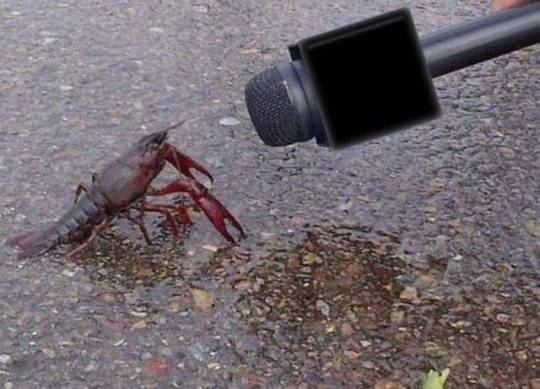
#196#lobster posting#lobster#lobsterposting#crustacean posting#crustaceanposting#crustacean#lobster facts#marine biology
197 notes
·
View notes
Text
Uncharismatic Fact of the Day
Lobsters in a tree? No, that's just the tree lobster! A member of the stick insect family, this species is considered one of the rarest insects in the world. They are endemic only to Lord Howe Island, a tiny island between New Zealand and Australia, and were believed to have gone extinct in 1918. However, a population of 24 live specimens was rediscovered in 2001, and extensive captive breeding has expanded the population to well over 10,000!
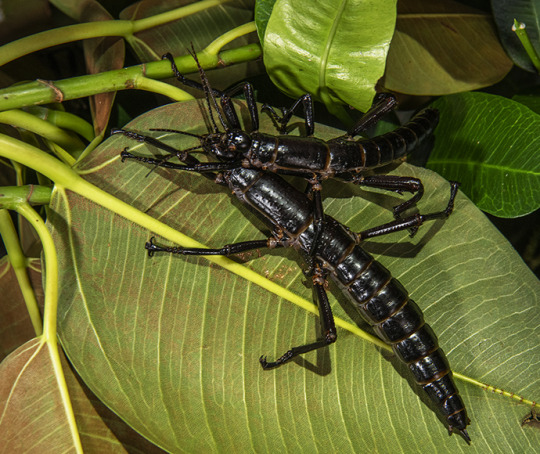
(Image: A pair of tree lobsters (Dryococelus australis) by Justin Gillian)
Want to request some art or uncharismatic facts? Just send me proof of donation of any amount to any of the fundraisers on this list, or a Palestinian organization of your choice!
432 notes
·
View notes
Text
The Lobster Nebula, where complex interactions b/w interstellar winds, radiation pressures, magnetic fields, & gravity have produced some really cool patterns of gas & dust. The nebula is massive, spanning ~400 light-years. It is also forming some of the largest known stars. 650 megapixel

#lobster#our universe#the universe#astrophotography#astronomy#nasa#astronomers#universe#nasa photos#outer space#astrophysics#nasawebb#hubble space telescope#astronomy photography#i love astronomy#astronomy facts#astronomy picture of the day#space exploration#space#science#space science#space travel#nasa science#science facts#planetary science#planetary nebula#nasaastronaut#nasa jpl#nasa astronauts#nasa picture of the day
136 notes
·
View notes
Text
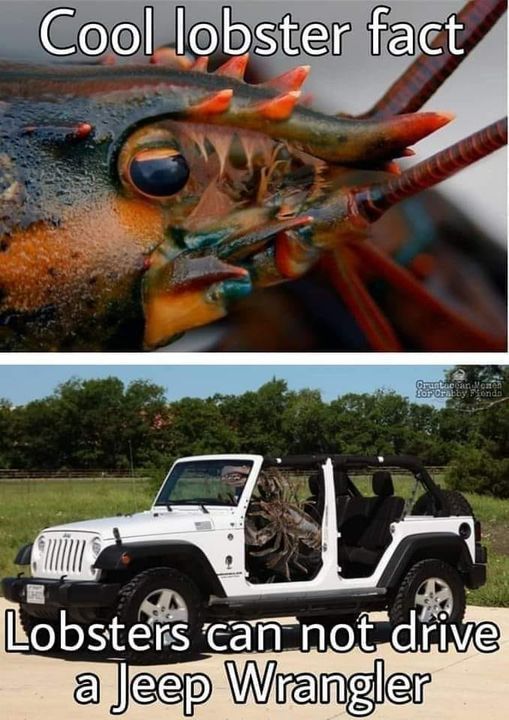
145 notes
·
View notes
Text
POV: You receive a text from your girlfriend, asking you to come over (Transfem Furina implied):

190 notes
·
View notes
Text
Wet Beast Wednesday: American lobster
This series takes us all over the world, but today we're going back to the good-ol' burger-drinking, beer-eating, eagle-worshiping U-S-of-A! The American lobster may be the world's most famous crustacean as they have become a major source of overpriced seafood. There's a lot to learn about this critter, so let's go check out the crustacean sensation that's sweeping the nation.

(Image: an American lobster seen from the side. It is a crustacean with 8 legs, a pair of large pincers, and a pointed head that has two long antennae and small eyes. The abdomen in elongated and segmented and ends with a fan-shaped tail. It is a greenish-brown color. End ID)
Homarus americanus is the largest lobster and largest crustacean, reaching a maximum recorded length of 64 cm (25 in) and weight of 20.1 kg (44.4 lbs). The average size is between 20 and 61 cm (8-24 in) and 680 to 910 grams (1.5-2 lbs). Lobsters are members of the family Nephropidae and despite the common names, they are not closely related to squat lobsters, slipper lobsters, or spiny lobsters. They are, however, closely related to crayfish. Lobsters are decapods, crustaceans with 10 limbs. Of the 5 pairs of limbs, the rear 8 are used for walking and the front two have become enlarged into a pair of powerful pincers used for defense and offense. The claws are asymmetrical and each serves different purposes. One claw is large and stout, with rounded, molar-like growths on the cutting edge. This claw is called the crusher claw and it is used to crush through hard-shelled food. The other claw is more slender and has a sharper cutting edge. This is the scissor claw and it is used to cut soft food into small enough pieces to eat. The crusher and scissor claws can be on either side of an individual lobster and very rarely a lobster will grow two crushers or two scissors instead of one of each. While the pincers can close with incredible force, they can't open with much force. This allows them to be held shut with rubber bands. The front two pairs of walking legs also have pincers, but they are much smaller. Lobsters can regrow missing legs. It can take up to 5 years for a missing pincer to regrow to the size of the original.

(Image: a lobster seen from the front, with the pincers in prominent view. One claw is bulkier than the other. The bulky claw has rough nodules on the cutting edge. The skinnier claw has serrated spines on the cutting edge. end ID)
Lobster anatomy is divided between two major segments: the cephalothorax and the abdomen. The cephalothorax contains the mouthparts, brain, legs, and many sensory organs. While they have eyes, they are weak due to lobsters spending most of their time on murky seafloors. Taste, smell,and touch are their primary senses. Antennae are used to examine the world and both the antennae and legs have sensory hairs called antennules on them that can detect the presence of chemicals in the water. Lobsters can both detect the smell of food and determine which direction it is coming from. The antennules also detect the motion of the water. Lobsters also urinate from a pair of bladders on the sides of the head. They can adjust the scent of the urine to communicate with each other. That's right, lobsters communicate by peeing on each other from their faces. The mouthparts consist of leg-like structures called maxillipeds that grab food and mandibles that help rip food up. Lobsters can't chew their food, but they have a structure in the esophagus called a gastric mill that grinds food down as it is swallowed. The abdomen is long and consists of multiple segments, allowing for flexibility. On the underside of the abdomen are feathery appendages called pleopods or swimmerettes. The first pair of swimmerettes is modified into sex organs called gonopods which can be used to differentiate males from females. The remaining pairs are used to circulate water around the lobster, helping keep fresh water over the internal gills. At the tip of the abdomen is a large, fan-shaped tail. By quickly curling the abdomen under their bodies, lobsters can generate thrust and send themselves shooting backwards. This is done to escape perceived threats.

(Image: a lobster standing on sand with its abdomen curled under its body. End ID)
Like other crustaceans, lobsters periodically outgrow their exoskeletons and must molt. After molting, the lobster will have a new, soft exoskeleton that takes time to harden. This period of softness leaves lobsters much more vulnerable to predators, so they will usually hide until their new shell hardens. They also eat the old shell to regain the nutrients and minerals it holds. The period after molting is also when females become fertile. A molted female will release pheromones that attract males. The male performs a courtship dance and if the female approves, he will use his gonopods to transfer a packet of sperm into her shell. The female can store this packet for over a year before using it. She lays thousands of eggs at once eggs and fertilizes them with the sperm as they come out. The eggs stick to her swimmerettes and she will work to keep them clean and keep air circulated over them. The clusters of eggs allegedly look similar to raspberries and a female with eggs is said to be "in berry". I personally don't see it. The eggs develop for 10 to 11 months before hatching, wherupon the female shakes her tail to dislodge the larvae. The larvae start out as a tiny, planktonic form called a metanapulus that drifts near the surface of the water and eats plankton. After their 4th molt, the larvae takes on a sub-adult form more similar to an adult, though they are still small enough to swim with their swimmerettes. Approximately 1 in 1,000 larvae will live long enough to reach this stage. After another molt, the sub-adult takes on its final form and sinks to the bottom, where they will gradually grow into an adult. Lobsters molt up to 10 times in their first year, then may one molt once every few years. By the time a lobster is large enough for anglers to legally keep, they will have undergone around 25-27 molts. There isn't really a maximum age for lobsters. They don't go through the same aging process as most animals. Lobsters have the ability to repair the damage to DNA that causes aging. While they will not age to death, you are unlikely to find thousand year old lobsters roaming about. Each molt takes more energy than the previous one and a lobster that doesn't die of predation, disease, or injury will eventually become unable to complete a molt and will die as a result. Most estimates place the maximum age for lobsters at about 100 years, but there are unconfirmed reports of lobsters reaching 140 years.
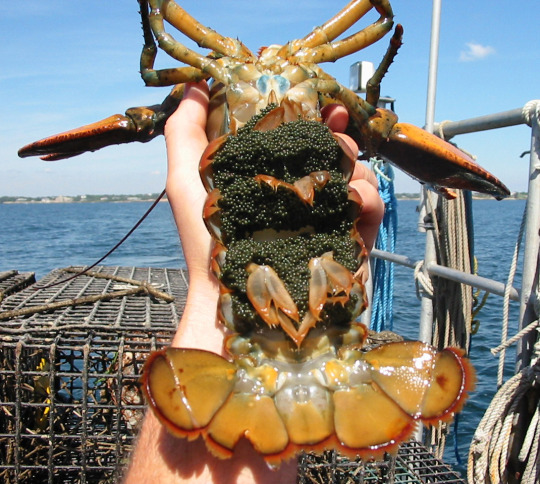
(Image: somebody holding a lobster so the underside of the abdomen is visible. This lobster is a female with masses of small, black eggs on her abdomen. End ID)
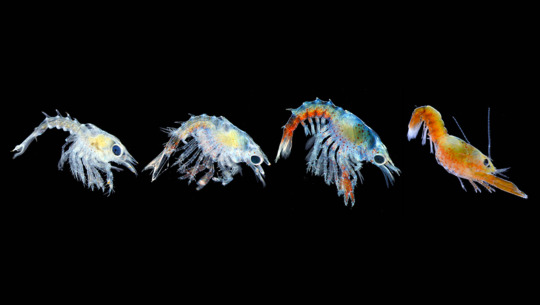
(Image: A lobster larva shown in the first four molts. The first three stages look more like transparent shrimp than lobsters. The final stage looks that a miniature lobster and is orange. End ID)
You would be hard-pressed to find a fictional depiction of a lobster that isn't bright red, but wild lobsters aren't that color. Most range from greenish-blue to greenish-brown, good colors for hiding amongst rocks and seaweed. That being said, American lobsters are famous for their wide range of color variants. Lots of people have herd of blue lobsters, but there are actually quite a few color options caused by genetic traits that overproduce certain pigments. Because of the rareness of these traits and the colorful lobsters being more at rick of predation, they are quite rare. Still, many color variants have been seen including blue ( 1 in 10 million lobsters), red (though not as bright as cooked lobsters. 1 in 30 million), bright yellow (1 in 30 million), calico (yellow and blue spots, 1 in 25 million), split down the middle (1 in 50 million), and white (albino or leucistic, 1 in 100 million). Many lobster anglers seem to agree that if they catch colored lobsters they should either be released or donated to aquariums or scientific organizations as opposed to being eaten. Reports of color variants have increased in the last 20ish years. This may be due to overfishing of their predators, but it may also be that social media allows sightings to be reported more easily.


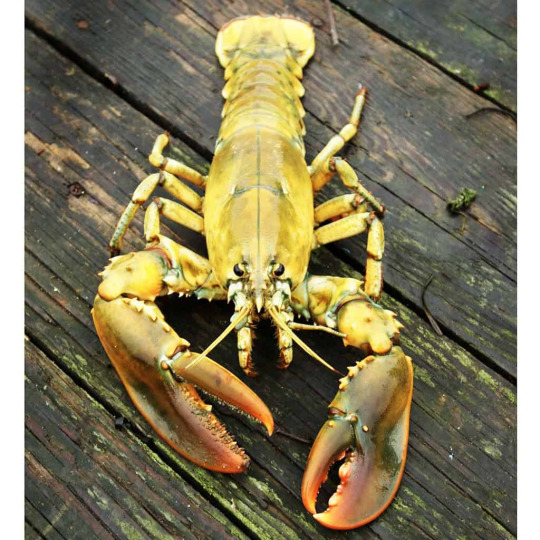



(Images: 6 pictures of lobster color varaints. Let to right, top to bottom: blue, red, yellow, calico, split, white. End ID)
American lobsters are found in cold, coastal waters of the Atlantic Ocean from the USA to northern Canada. They are famously highly abundant around the state of Maine, which has the world's largest lobster fishery. They prefer rocky bottoms with plenty of places to hide. Despite those big claws, lobsters are rather timid. They spend a lot of their time hiding and are quick to use their tails to flee. If pressed, they will use their powerful claws to fight. While occasionally active in the day, lobsters are mostly nocturnal, coming out at night to find food. Speaking from personal experience, I did a night SCUBA dive in Maine and there were so many lobsters I could barely see the seafloor. American lobsters are territorial and will fight over food, shelter, and mates. When they live in close quarters, lobster will establish a dominance hierarchy based largely on size. They use chemical signatures to identify themselves and communicate. The diet of an American lobster mostly consists of small invertebrates such as worms, slugs, clams, and crabs, but they also eat carrion and algae and seagrass. Lobsters in captivity have been known to engage in cannibalism, but this has never been seen in the wild.
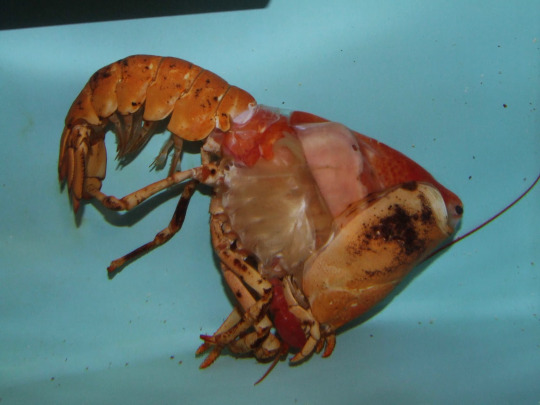
(Image: a lobster molting. The carapace on the back of the cephalothorax has come off and the soft-bodied lobster is emerging through the gap created. End ID)
The American lobster is a popular food source and so is fished heavily in the northern USA and Canada, with the state of Maine and Atlantic province having the largest industries. The vast majority of lobster fishing is done with special lobster traps, sometimes called pots. These are cages baited with dead fish that have funnel-shaped entrances. The idea is that the shape of the entrance lets lobsters in, but makes it hard for them to get out. Humorously, lobster traps have been found to be incredibly inefficient, all but the largest lobsters can enter and leave freely. The lobsters that get caught tend to be the ones unlucky enough to be in the trap when it's pulled up. Bait has been found to comprise a large portion of the diet of lobsters in Maine and individual lobsters have been known to claim traps as their territory and fight off others trying to enter them. Modern traps are also required to have holes allowing lobsters below the size limit to leave easily. The inefficiency of lobster traps has allowed the population to remain stable despite the incredibly heavy fishing. in addition, there are many regulations to protect the species, including requirements to release small lobsters and egg-bearing females. There is no lobster aquaculture doe to how long it takes them to reach a usable size. Commercial lobster fishing started with poor laborers who could get them cheap due to how abundant the lobsters were in the area. As with so many other things, the rich came, took an idea created by the poor, and drove up prices so much the original people could no longer afford their own invention. Lobsters are traditionally cooked by boiling, usually with the lobster still alive at the time. The ethics of live cooking lobsters is debated. Some insist their brains do not have the regions responsible for feeling pain while others point out they still respond negatively to stimuli and therefore can still feel some kind of distress even if it isn't the same as human pain. Some jurisdictions have made live boiling illegal and require the lobster to be dead first. Freezing the lobster or a stab through the cephalothorax are offered as more humane than boiling. The American lobster is classified as least concern by the IUCN, meaning they are not at risk of extinction.
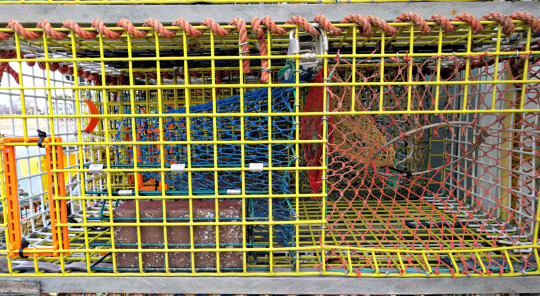
(Image: a modern lobster trap. It is a rectangular wire cage painted yellow. There are two chambers inside. The first chamber has two openings to the outside and is where bait is placed. The second chamber has another funnel-shaped opening to the first chamber and is intended to trap the lobsters within. An opening on the side of the second chamber allows small lobsters to escape. A brick is used to weigh the cage down. End ID)
#wet beast wednesday#lobster#american lobster#homarus americanus#crustaceans#decapod#decapoda#marine biology#biology#zoology#ecology#animal facts#informative#educational#invertebrate#invertebrates#image described
86 notes
·
View notes
Text
Can someone please tell me who this is
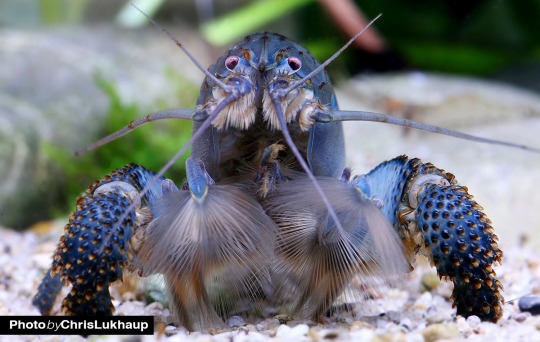
#why is this fellow furry ???? is it a regular lobster or crawfish or is it a different species???#were some lobsters/crawfish furry looking like this and I just didn’t know this whole time??#he looks like an animal crossing character to me#me posting#crustacean#ocean people please answer me thank you#marine biology#yes I tried google reverse image search she told me it is a blue crawfish but as someone who knows fuck all about crawfish and saw that all-#the crawfish pics were NOT in fact furry looking fellows I was confused and sceptical of google’s accuracy
24 notes
·
View notes
Text

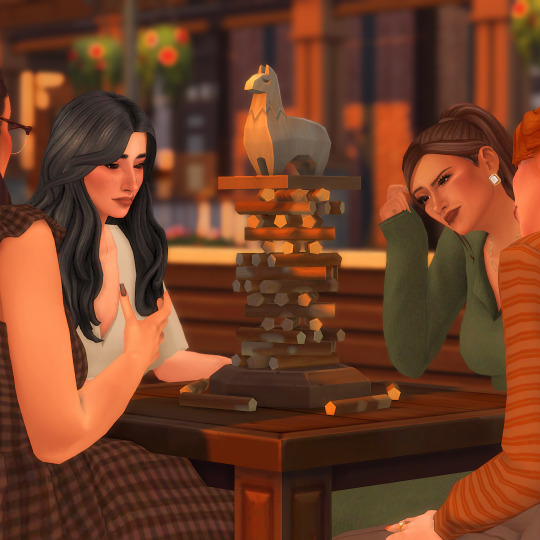




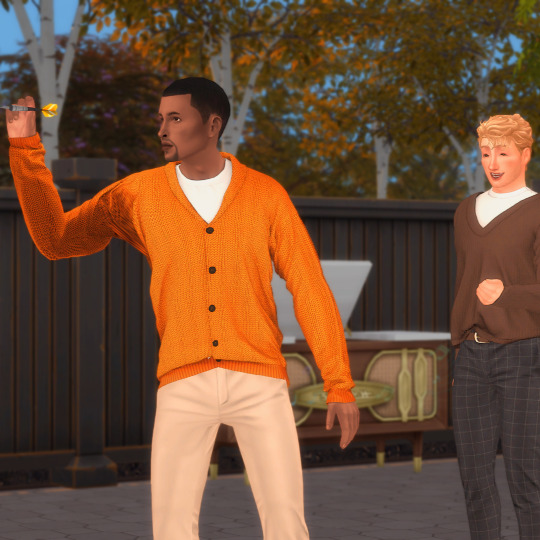
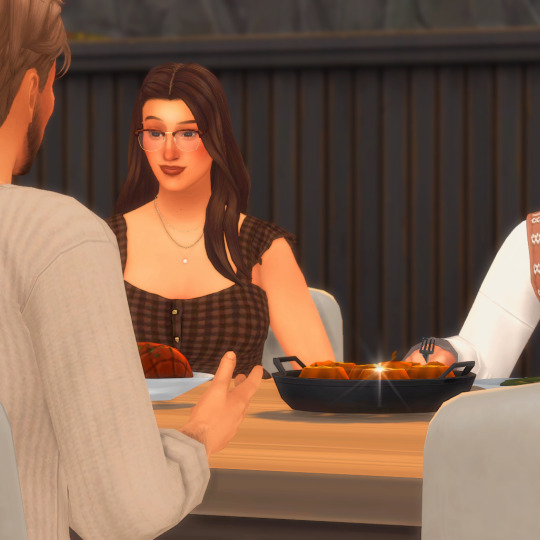


Harvestfest at the Fyres Home 🍂
#commentary tags at the end lol#dulce alegria#noemi alegria#erick wade#angel alegria#teodor medina#irene quintanilla#guillermo medina#hilary laurent#moira fyres#dominic fyres#matthew fyres#tjolc gen 1#tjolc#alegria legacy#matchalovertrait#sims 4#ts4#the sims 4#sims 4 legacy#fun fact: dulce made the stuffed pumpkin! she tried moira's lobster but erick ate the stuffed pumpkin that his daughter made :)#dulce turns 14 very soon btw!! we’re wrapping things up#also it's rlly hard to see here but teodor + dominic + hilary + moira have more wrinkles now
63 notes
·
View notes
Note
How chronically ill would tom be? To body aches or intense AAAAAAAAAAAAAAAAAAAAAAAAAAAAH-ing
tom's mutation(?) demon(?).... uh 'monster' gives him many useful abilities (heightened senses like smell and hearing, 'super strength') however it's at the cost of his health. overtime the 'monster' side begins degrading his body. current tom experiences little of the side effects due to the fact it's a more recent development of his biology. he does have the occasional day where he experiences extreme joint pain, particularly in his knees. future tom has it pretty bad. on top of the migraines caused by his visor, he has to deal with a unique blood disorder. nobody can figure out why his blood has turned purple except for the fact its connected to the monster. the chronic pain has gotten pretty bad at that point as well. some days he just cant get himself to leave his apartment,. let alone his room. good thing matt is always willing to take days off to help tom. this is also the reason why tom is relegated to menial office work. poor guy just cant go out on the field anymore
#tomeeposts#tord feels immensely guilty about what he did to tom but he'll never admit it#makes edd hate him even more despite the fact that tom isnt really his best friend anymore#matt tries his best to make toms life comfortable#hes taken up baking so he can have pies for tom on his worse days#their pet lobster matt jr is the best emotional support animal
40 notes
·
View notes
Text
miku fun fact #54
miku would like lobster maybe or not
34 notes
·
View notes
Text


Mo regards every grocery store lobster tank with distrust and fear 🦞🦞🦞
#this is true btw i was in fact scared of that as a kid#and lobsters and crabs are still freaky lmao#hellsona#hhoc#hazbin hotel oc#arackniss#soursugar#mo's art#;;hazbin hotel#sweet and sour
16 notes
·
View notes
Text
tumblr convinced me that luke black is actually from a 90s anime and in that moment i became a vessel for the truth and these are the results (aka my luke black art dump which resulted in me becoming obsessed with 90s cyborg anime)
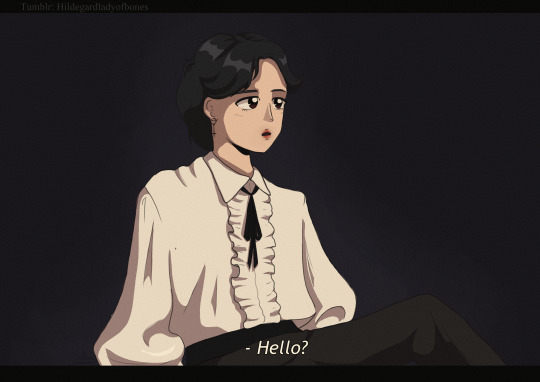
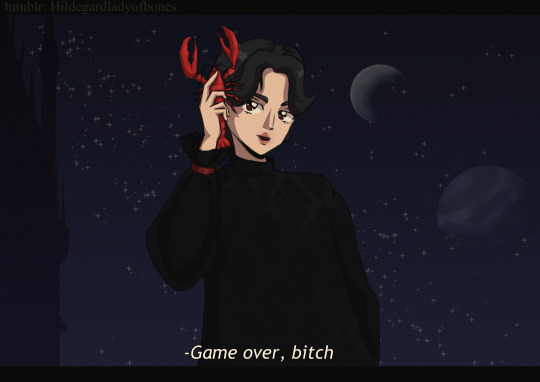
fun fact: this file is named lobster twinkovic in my computer

how does he sleep with all of those LEDs? we'll never know

here's a secret extra drawing with a secret extra lineart of Jann (my beloved) who is canonically from the same anime as luke black. i also changed the style because my style is as fluid as my gender
#fun fact: i downloaded twitter for luke black#he is extremely funny#eurovision#esc#esc 2023#eurovision 2023#art#eurovision serbia#luke black#samo mi se spava#lobster twinkovic#jann#jann gladiator#jann fanart#luke black fanart#fanart#90s anime#anime style#anime art#anime
166 notes
·
View notes
Note
Which kind of lobster is cooler, in your professional opinion? Warm water spiny lobsters, or whatever Maine has?
I think spiny lobsters are neat because they look kind of more like a huge shrimp but Maine lobsters are superior by virtue of being humongous and having big claws for peench
#lobsters#also I just don’t know that much about spiny lobsters#so I can’t really compare them by number of fun facts
23 notes
·
View notes
Note
"Eggers' version, a verbose and full-blooded Gothic melodrama, fleshes out the character of Ellen and accentuates the 'love' story. This aspect might remind some viewers of Francis Ford Coppola's Bram Stoker's Dracula, a movie that Eggers watched many times as a child..."
Well that is not very promising
Ohhh the impact of Francis' erotic fanfiction (derogatory)
The upside: Technically this is not Jonathan and Mina getting screwed over again. Huzzah.
The downside: Now Thomas and Ellen Hutter, the copyright skirting un-Harkers, are getting just as screwed over as their inspirations. Because not even the best directors are immune from the apparently desperate need to turn other people's work into a vampire fetish flick rather than just making their own characters to play with. Which is especially galling when the original Nosferatu's Ellen made her sacrifice explicitly to save Thomas and humanity at large from Orlok. I have my fingers crossed that Eggers will at least try to wring out a different gothic tragedy twist--one in which Ellen, now fully gothically enamored with Orlok for Reasons still acknowledges that he's a monster and to let him go on will mean death and misery for everyone. So she still goes through with the original film's ploy of distraction until sunrise, cue demise.
But considering this is the same guy behind The Witch and The Lighthouse, there may be a more sinister knife twist ending involved. Maybe a little closer to the 1979 version's gut punch, give or take some character swapping. I don't know.
On the one hand I am genuinely excited for this movie because Eggers is a master of atmosphere and building off the bones of folkloric horror for some seriously unnerving stories. On the other hand, I feel about this the same way I felt about Guillermo del Toro praising Francis' Dracula. Learning that a creator you deeply admire applauds a work (and a trend) you deeply deplore just sucks. No way around it. Sigh.
#it's like sitting in a great restaurant and trying over and over to order A Specific Dish#and the chef happily delivers you an admittedly well-made dish with that name but is patently Not That Dish#'Sir I ordered a lobster bisque.'#'And I gave you one :)'#(he has given me a smoked salmon. the fact that lobsters and fish both come from the water = enough resemblance to call it lobster bisque)#nosferatu#nosferatu 2024#dracula
12 notes
·
View notes
Text
there are many ways to inhabit adulthood, but even after a week of my new job, of running errands, talking with colleagues and loved ones---the thing I am most proud of is remembering to put on sunscreen before I take myself to the zoo.
#is it perhaps linked to the fact that one of the head honchos is going to be in town next week#and I didn't want to look like a boiled lobster when I met him?#is that the reason I remembered sunscreen for the first time in many many years???#maybe so.#celestial emporium of benevolent knowledge
87 notes
·
View notes